| Author |
Message |
|
Christian Böhling
Industry Professional
|
 Posted: Mon 01 Feb, 2010 2:51 am Post subject: Posted: Mon 01 Feb, 2010 2:51 am Post subject: |
 |
|
| Peter Johnsson wrote: | It is interesting that the forward mount of the hilt is so very celtic looking, with its curved shape.
I would love to learn more about the double edged sword used by the germanic tribes before the roman spatha came into wide use. At present I wonder a lot about the germanic versions of hilts put on these imported roman sword blades (and those possibly made locally after roman pattern). There seems to be several local hilt types and I wonder how and if these relate to contemporary roman type hilts.
I know there were copies of celtic long swords made by germanic smiths in the 1st C BC (and into the 1st C AD?), but I have not seen many of these(only a small handful of old published drawings). In storage rooms in Swedish museums one can come across rusty remains of blades that may have been celtic, germanic or roman. They are often so far gone, it is difficult to see any distinguishing shapes.
Could you possibly share some info on finds where details of hilts, scabbards and blades survive?
 |
Hi Peter,
I made this sword in times when I was without a computer or a digi-cam, so all that I have is the find-drawind from the publication, glad that I found it among thousands of loose papers in the cellar... 
The last images are from the Nienbüttel sword, the first is a similair find from Großromstedt (Nienbüttel is near Hamburg and Großromstedt is in Saxony, bothe in the influental reach of the Elbe-River with connections to the Southeast (wher the influence - and maybe the weapon had come)
 Attachment: 101.29 KB Attachment: 101.29 KB
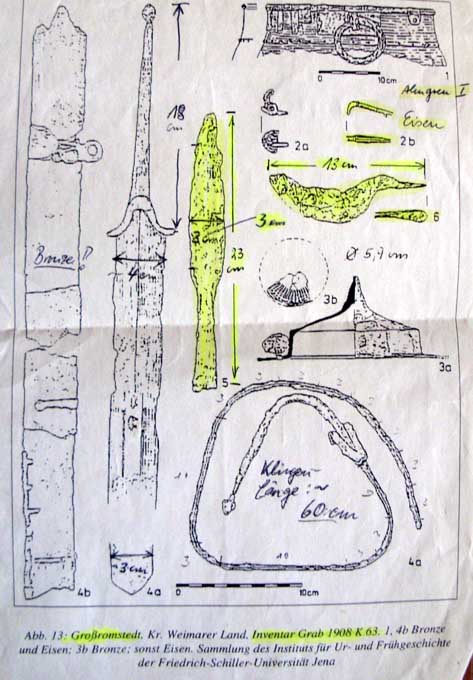
Großromstedt
 Attachment: 95.16 KB Attachment: 95.16 KB
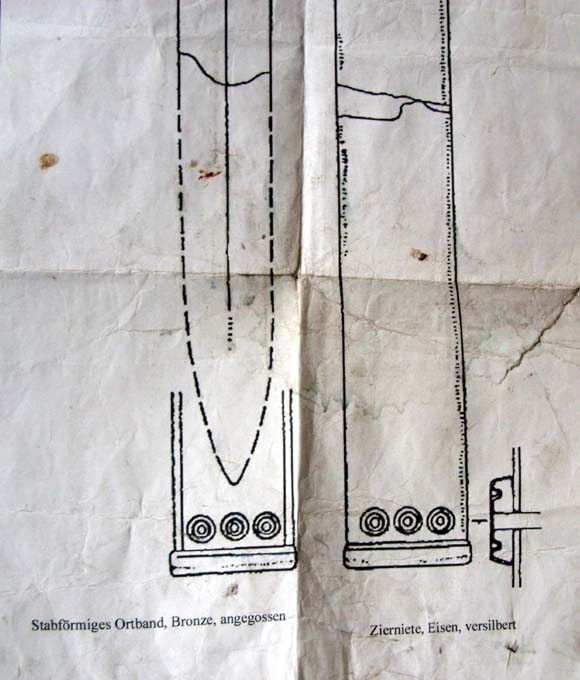
Nienbüttel
 Attachment: 93.46 KB Attachment: 93.46 KB
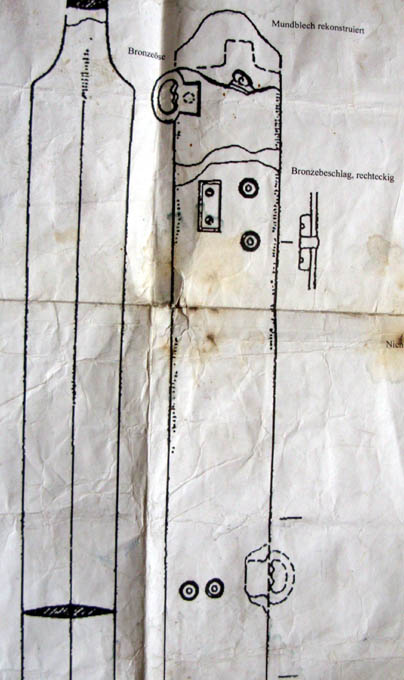
Nienbüttel
 Attachment: 101.42 KB Attachment: 101.42 KB
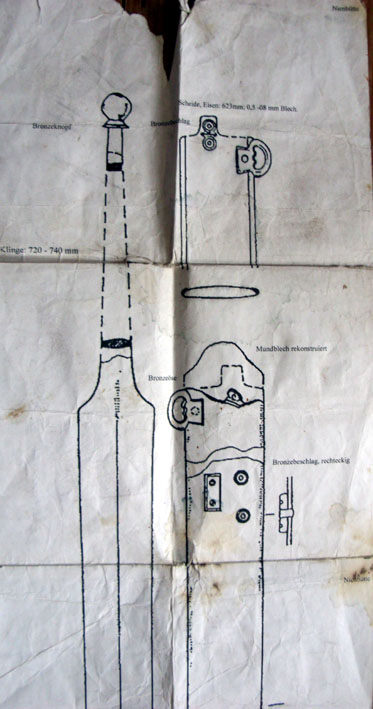
Nienbüttel
 Attachment: 99.76 KB Attachment: 99.76 KB

Nienbüttel
www.archaeoschmiede.de
www.eisenzeithaus.de
|
|
   |
 |
Nathan Robinson
myArmoury Admin


|
|
    |
 |
|
Christian Böhling
Industry Professional
|
 Posted: Mon 01 Feb, 2010 3:03 am Post subject: Posted: Mon 01 Feb, 2010 3:03 am Post subject: |
 |
|
I like this study of the Putensen sword, and I would love to see any drawings or documentations of the original as it seems to be so very similar to the Åsby sword. [/quote]
note the very small bronze piece at the lower left corner, it is bend around this corner, describing two circle plates (each on each side) connected with a broader strap. And note also the small fitting at the right edge of the grip-part....
 Attachment: 93.86 KB Attachment: 93.86 KB
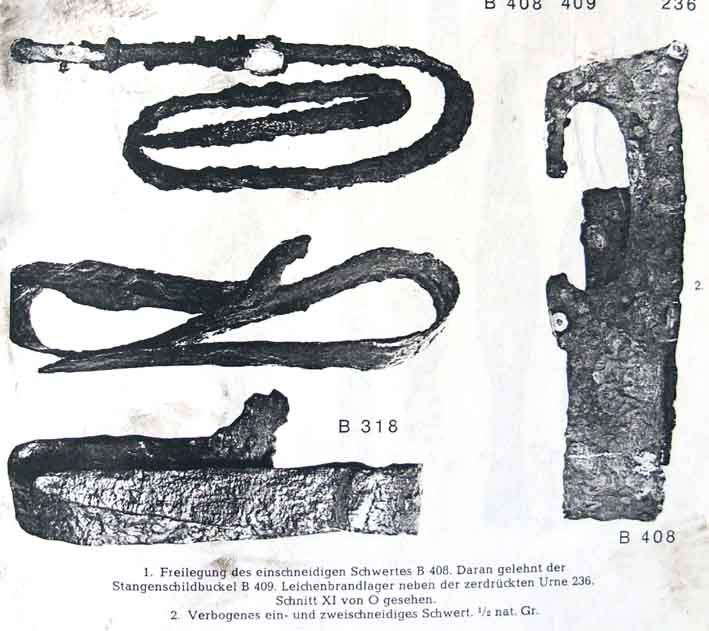
 Attachment: 99.65 KB Attachment: 99.65 KB
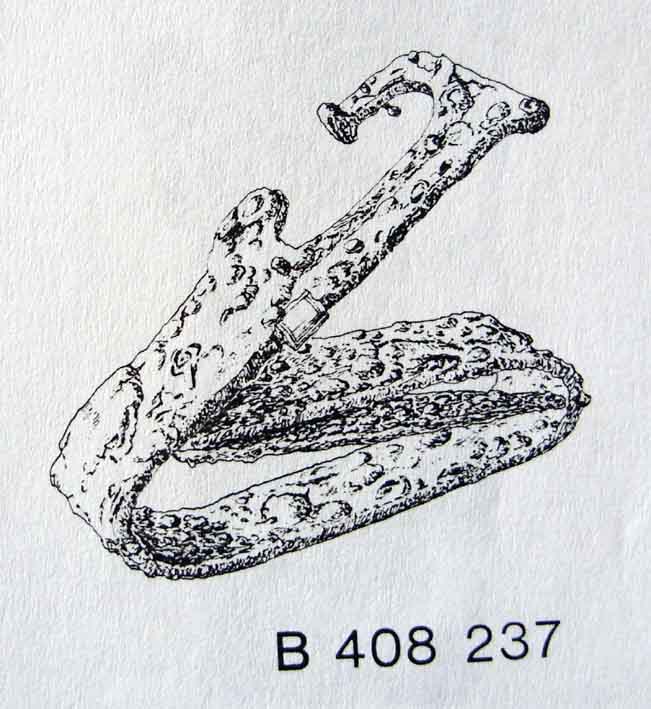
www.archaeoschmiede.de
www.eisenzeithaus.de
|
|
   |
 |
|
Christian Böhling
Industry Professional
|
 Posted: Mon 01 Feb, 2010 3:12 am Post subject: Posted: Mon 01 Feb, 2010 3:12 am Post subject: |
 |
|
| Peter Johnsson wrote: | Just some more observations on this interesting weapon from Vimose. It is dated to 2nd C AD. The type is found in specific areas (like Bornholm and eastern part of Sweden) whereas the imported spatha was more widely used elsewhere in germanic areas at this time in history.
|
BTW: on one sword with a brutal narrowing grip which I made many Years ago I attached a bone ending, which was broaden the grips end, because without it always wanted to slip through the fingers when used....so I had the same thoughts on this problem as Peter has and solved it with this attachment, but of course it was fictive....On this one (which was I think made by Thys van der Manneker) the end is a bit broader...but even this one is odd in it´s handling....
 Attachment: 102.52 KB Attachment: 102.52 KB
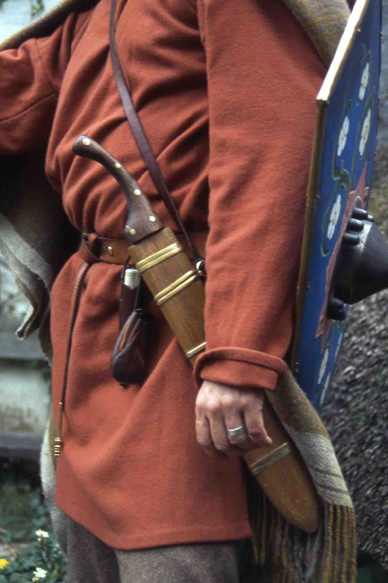
One of the "Chasuari" with a sword of this type
www.archaeoschmiede.de
www.eisenzeithaus.de
|
|
   |
 |
|
Christian Böhling
Industry Professional
|
 Posted: Mon 01 Feb, 2010 3:35 am Post subject: Posted: Mon 01 Feb, 2010 3:35 am Post subject: |
 |
|
....just an impression of how these swords have injured....
this image is from our special exhibition (ended)...and shows the skulls of a roman couple who had been slaughtered in their villa rustica by germanics.....
 Attachment: 89.09 KB Attachment: 89.09 KB
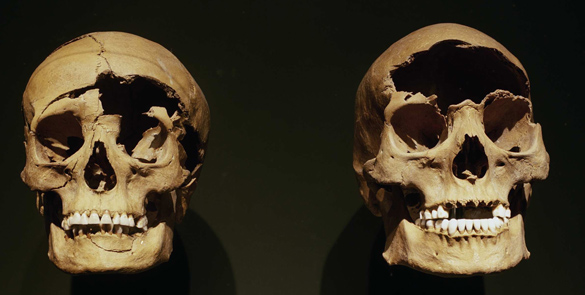
 Attachment: 95.2 KB Attachment: 95.2 KB
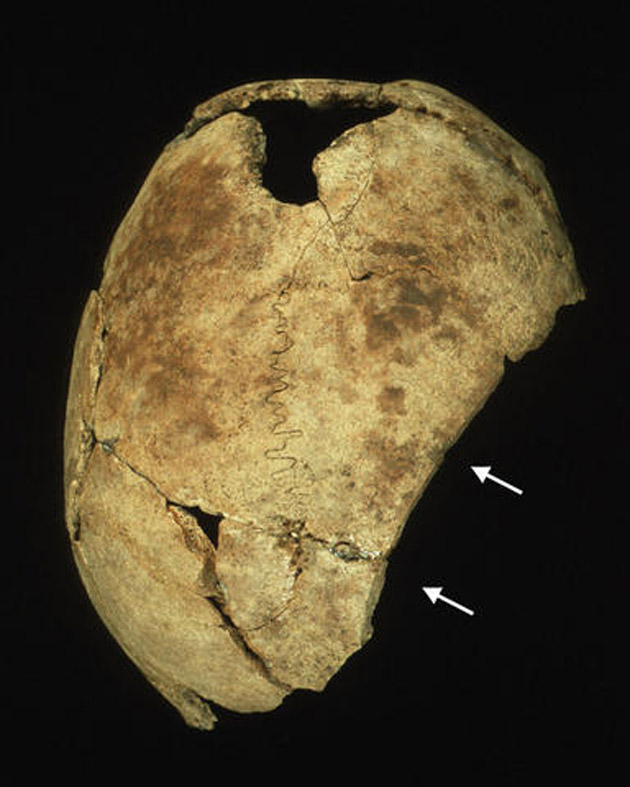
skull of a roman legionair excavated at the battlefield site of Kalkriese (9 A.D) shows that the right half of the skull was right cut off by a sword hit.
www.archaeoschmiede.de
www.eisenzeithaus.de
Last edited by Christian Böhling on Mon 01 Feb, 2010 3:40 am; edited 1 time in total
|
|
   |
 |
|
Peter Johnsson
Industry Professional
|
 Posted: Mon 01 Feb, 2010 3:37 am Post subject: Posted: Mon 01 Feb, 2010 3:37 am Post subject: |
 |
|
| Christian Böhling wrote: |
note the very small bronze piece at the lower left corner, it is bend around this corner, describing two circle plates (each on each side) connected with a broader strap. And note also the small fitting at the right edge of the grip-part.... |
Christian, thanks!
I love this find! So many interesting details. The nice round rivet washers, similar to the Woerden sword. The T-shape at the end of the back spur. The bronze plate over the back edge of the grip towards the blade. This was a very beautiful sword once!
(And yes: you seem to be correct in your interpretation of the section of the tang. There seem to be no or very little wedge shape going on, rather a uniform thickness from one edge to the other.)
Last edited by Peter Johnsson on Mon 01 Feb, 2010 3:58 am; edited 1 time in total
|
|
   |
 |
|
Peter Johnsson
Industry Professional
|
 Posted: Mon 01 Feb, 2010 3:45 am Post subject: Posted: Mon 01 Feb, 2010 3:45 am Post subject: |
 |
|
Thanks also for those pics on the double edged swords!
I wonder about those little embellishments on the Nienbüttel sword´s scabbard. It looks like they cover some earlier mounts? Could they have been some elements to attach leather belts: a kind of wrap around that passed through the open loops?
Also, I wonder about the reconstructed shape of the scabbard mouth? Could it have been straight instead of bell shaped? (like some other late la Tene III swords)
The chape, or bottom ending of the scabbard is also a nice detail. So different from those large ladder shaped chapes of late celtic sword scabbards.
But the one from Großromstedt seems to have had such a celtic looking chape? There are remains of "ladder rungs" on the scabbards lower part...
Very interesting!
|
|
   |
 |
|
Jeroen Zuiderwijk
Industry Professional
|
 Posted: Mon 01 Feb, 2010 3:58 am Post subject: Posted: Mon 01 Feb, 2010 3:58 am Post subject: |
 |
|
| Peter Johnsson wrote: | Christian, I like your interpretation of the germanic "La Téne" sword!
I note especially the interpretation of the hilt: did the original have such a very roman looking rivet button?
If so, do you think it is realistic to imagine it had a spherical or hamburger shaped pommel rather than the half moon one? It is interesting that the forward mount of the hilt is so very celtic looking, with its curved shape. |
Jumping in on La Tene swords with rivet buttons and curved guards, I'm going to do a reproduction of one this year (if the wrought I have for it cooperates). I'm going for the Dutch type that includes bronze rings in the grip, such as these examples:



Unfornately, I can't find any details on dating nore on potential grip pommel/bolster shapes for these swords. The dating I always encounter is 500-0BC, which of course is rather useless. Can anyone date them more accurately? I've been wondering about the material between the bronze rings, whether it may have been wood or bone or horn. I'm now actually considering that leather may have been likely as well. Perhaps even more likely, as one of the swords has lots of very thin rings with very thin spaces between.
Jeroen Zuiderwijk
- Bronze age living history in the Netherlands
- Barbarian metalworking
- Museum photos
- Zip-file with information about saxes
|
|
   |
 |
|
Peter Johnsson
Industry Professional
|
 Posted: Mon 01 Feb, 2010 6:32 am Post subject: Posted: Mon 01 Feb, 2010 6:32 am Post subject: |
 |
|
The battle knives/daggers carried by these germanic warriors also commands some interest.
Type and shape varies by location. In the danish bog finds the origin of invading/defeated forces could be identified by the shape of personal equipment, like combs, personal knives fire strikers and so on. The double edged swords (spathe) were (more or less?) alike all over the germanic area, since they were imports or copies of imported blades. In the centuries after year 1, the single edged sword lost importance pretty rapidly and the double edged sword gained widespread popularity.
Knives and daggers did still form an important part of the equipment: it was the personal "civilian" equipment that singled out the individual fighter, while spears, shields and swords were of more uniform type. Warriors from different areas ad combs and fire strikers that were typical for their land ends. Spears and axes were forged locally and would therefore also show local variation in form.
Below are a few knives from the Illerup Ådal find.
I find their shape very beautiful. Simplified and suggestive curves. Cross section is a strong triangle. The large knives were often made from iron, while the smaller "civilian" type knives had edges of hardened steel.
 Attachment: 82.44 KB Attachment: 82.44 KB
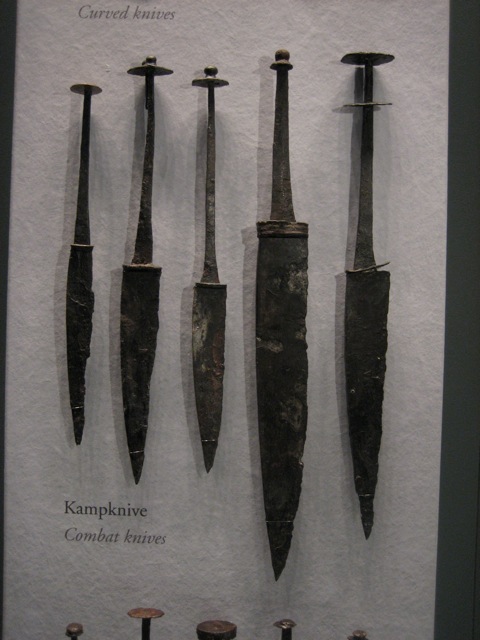
Note that some of the large daggers/knives have rivet buttons like some of the double edged swords posted above. Influence from roman cutlery is strong.
Last edited by Peter Johnsson on Mon 01 Feb, 2010 6:50 am; edited 2 times in total
|
|
   |
 |
|
Luke Zechman
|
 Posted: Mon 01 Feb, 2010 6:33 am Post subject: Posted: Mon 01 Feb, 2010 6:33 am Post subject: |
 |
|
|
This thread is amazing! I have not been able to read all of it yet, and already I am learning so much. Thanks to anyone contributing information, and works in progress. Keep it going!
|
|
  |
 |
|
Christian Böhling
Industry Professional
|
 Posted: Mon 01 Feb, 2010 6:40 am Post subject: Posted: Mon 01 Feb, 2010 6:40 am Post subject: |
 |
|
| Jeroen Zuiderwijk wrote: |
Jumping in on La Tene swords with rivet buttons and curved guards, I'm going to do a reproduction of one this year (if the wrought I have for it cooperates). I'm going for the Dutch type that includes bronze rings in the grip, such as these examples:
Unfornately, I can't find any details on dating nore on potential grip pommel/bolster shapes for these swords. The dating I always encounter is 500-0BC, which of course is rather useless. Can anyone date them more accurately? I've been wondering about the material between the bronze rings, whether it may have been wood or bone or horn. I'm now actually considering that leather may have been likely as well. Perhaps even more likely, as one of the swords has lots of very thin rings with very thin spaces between. |
Jeroen,
the Nienbüttel sword was found together with a fibula Type Almgren 19 a which allows to date this sword inner a few ten years around the year 0 (maybe 20 B.C to 20 A.D). This might be the stop-point in the long last of these swords
www.archaeoschmiede.de
www.eisenzeithaus.de
Last edited by Christian Böhling on Mon 01 Feb, 2010 12:53 pm; edited 1 time in total
|
|
   |
 |
|
Christian Böhling
Industry Professional
|
 Posted: Mon 01 Feb, 2010 6:52 am Post subject: Posted: Mon 01 Feb, 2010 6:52 am Post subject: |
 |
|
| Peter Johnsson wrote: | The battle knives/daggers carried by these germanic warriors also commands some interest.
Type and shape varies by location. In the danish bog finds the origin of invading/defeated forces could be identified by the shape of personal equipment, like combs, personal knives fire strikers and so on. The double edged swords (spathe) were alike all over the germanic area, since they were imports or copies of imported blades. In the centuries after year 1, the single edged sword lost importance pretty rapidly and the double edged sword gained widespread popularity.
Knives and daggers did still form an important part of the equipment.
Below are a few from the Illerup Ådal find.
I find their shape very beautiful. Simplified and suggestive curves. Cross section is a strong triangle. The large knives were often made from iron, while the smaller "civilian" type knives had edges of hardened steel. |
I add some images of a Illerup-knife (this is one I made just for fun)
The scabbard has the same bar-like ending as some swords I posted here....this was Ilkjaers Interpretation of some small wooden little sticks found at the tip of many knifes in Illerup Place A.....
 Attachment: 95.63 KB Attachment: 95.63 KB
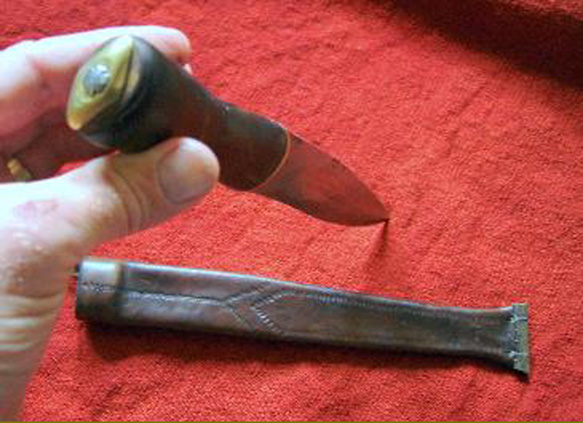
 Attachment: 82.72 KB Attachment: 82.72 KB
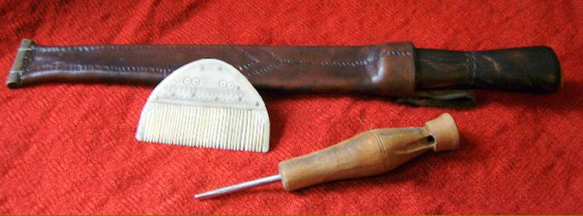
 Attachment: 91.24 KB Attachment: 91.24 KB
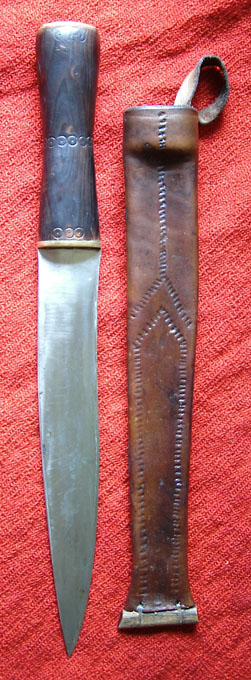
www.archaeoschmiede.de
www.eisenzeithaus.de
Last edited by Christian Böhling on Mon 01 Feb, 2010 6:59 am; edited 2 times in total
|
|
   |
 |
|
Peter Johnsson
Industry Professional
|
 Posted: Mon 01 Feb, 2010 6:57 am Post subject: Posted: Mon 01 Feb, 2010 6:57 am Post subject: |
 |
|
Examples of battle axes wielded by warriors from scandinavia in the second or third C AD. Very different from the famous viking axes of later times...
The haft was pushed on from the front end of the head, just like you haft a tomahawk (note the swelling at the forward end of the head: a stop like the "pommel" of a baseballbat). I
 Attachment: 69.61 KB Attachment: 69.61 KB
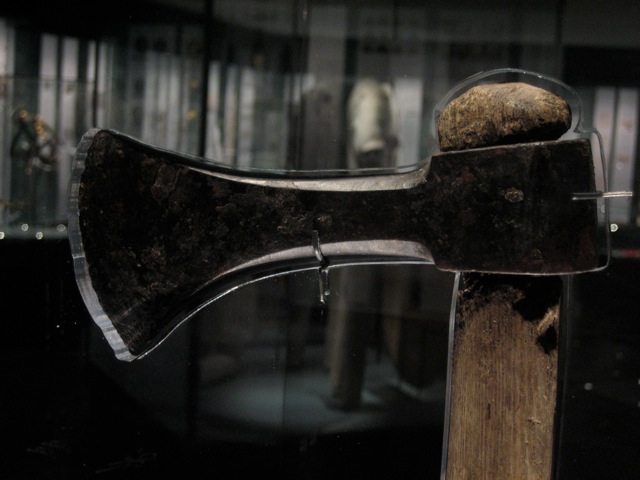
 Attachment: 83.68 KB Attachment: 83.68 KB
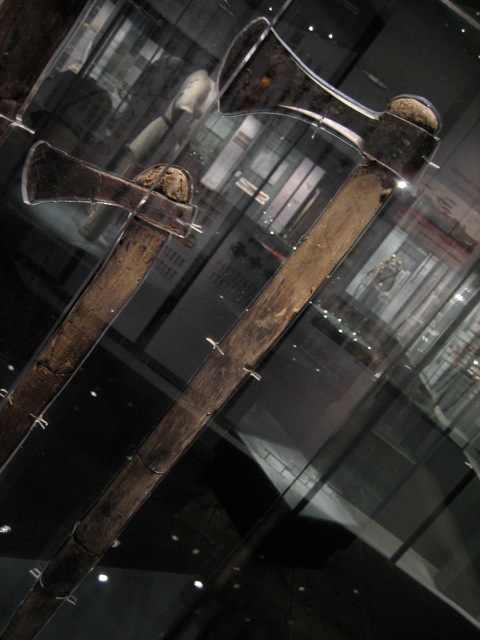
|
|
   |
 |
|
Myles Mulkey
|
 Posted: Mon 01 Feb, 2010 7:11 am Post subject: Posted: Mon 01 Feb, 2010 7:11 am Post subject: |
 |
|
Peter,
Do you happen to know what find these axes are from? I can't remember for the life of me, but I think they are of a later date than the ones you posted.
Also, I'd like to see something said about the type of decoration on Illerup spearheads, since it seems to be a pretty established style found on multiple spears.
 Attachment: 105.33 KB Attachment: 105.33 KB
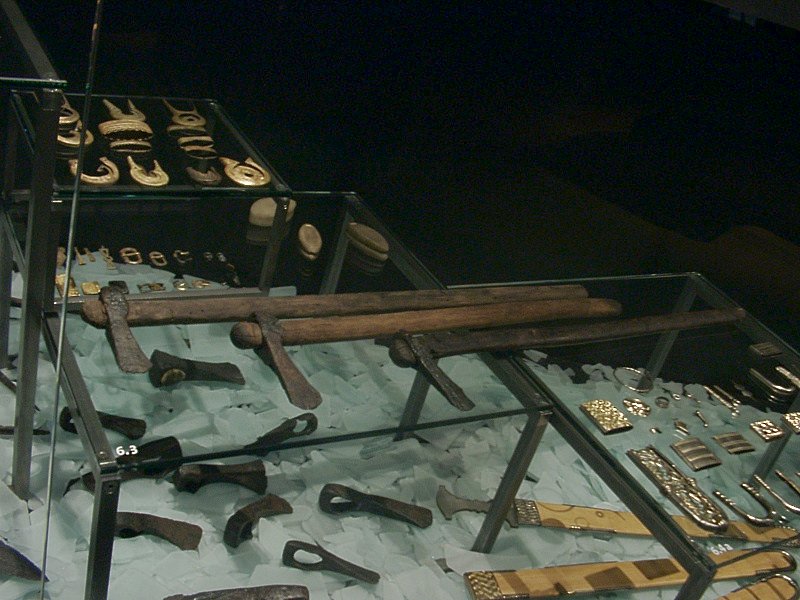
The axes in question, I think from the Roman Iron Age
 Attachment: 117.69 KB Attachment: 117.69 KB
Lance chronology [ Download ]
 Attachment: 146.33 KB Attachment: 146.33 KB
Lance heads with decoration [ Download ]
 Attachment: 85.82 KB Attachment: 85.82 KB
Lance heads with decoration [ Download ]
|
|
  |
 |
|
Myles Mulkey
|
 Posted: Mon 01 Feb, 2010 7:43 am Post subject: Posted: Mon 01 Feb, 2010 7:43 am Post subject: |
 |
|
| Luke Zechman wrote: | | This thread is amazing! I have not been able to read all of it yet, and already I am learning so much. Thanks to anyone contributing information, and works in progress. Keep it going! |
I agree! I'll keep watching this one. 
|
|
  |
 |
Artis Aboltins

|
 Posted: Mon 01 Feb, 2010 7:56 am Post subject: Posted: Mon 01 Feb, 2010 7:56 am Post subject: |
 |
|
| Myles Mulkey wrote: | | Luke Zechman wrote: | | This thread is amazing! I have not been able to read all of it yet, and already I am learning so much. Thanks to anyone contributing information, and works in progress. Keep it going! |
I agree! I'll keep watching this one.  |
Perharps it would be more apropriate to move it from makers and Manfacturers forum to the Historical Arms Talk? And, indeed, there is wealth of information in this thread.
|
|
  |
 |
|
Myles Mulkey
|
 Posted: Mon 01 Feb, 2010 8:48 am Post subject: Posted: Mon 01 Feb, 2010 8:48 am Post subject: |
 |
|
| Artis Aboltins wrote: | | Myles Mulkey wrote: | | Luke Zechman wrote: | | This thread is amazing! I have not been able to read all of it yet, and already I am learning so much. Thanks to anyone contributing information, and works in progress. Keep it going! |
I agree! I'll keep watching this one.  |
Perharps it would be more apropriate to move it from makers and Manfacturers forum to the Historical Arms Talk? And, indeed, there is wealth of information in this thread. |
I second that!
|
|
  |
 |
|
Shane Allee
Industry Professional
|
 Posted: Mon 01 Feb, 2010 8:51 am Post subject: Posted: Mon 01 Feb, 2010 8:51 am Post subject: |
 |
|
Christian the spears look really nice. There are not a lot of people out there doing them right. Know that I have been burnt a few times by people cutting corners or who turned out to not be able to do it correctly.
It did not take long for the whole issue to come up about the mixing of the “Germanic” and “Celtic” culture and objects to come up. There really seems to be some interesting stuff going on between the two. I’ve heard that there was at least one tribe that followed the material culture that is considered Celtic, but was not celtic speaking. Some appear to have been pretty mixed with objects from both cultures in the same context. Want to that someone told me that some genetic research seemed to confirm a mixture. Really should be expected since we see the same kind of thing along the Thracian borders as well.
A couple years ago I was able to get my hands on a copy of a book that covers some of these late La Tene mixed finds. Just wish that I’d had a chance to translate and read more of it. I have been wanting to do one of the single edged swords in there, but not got around to it yet. Glad now since I hadn’t considered that they might not have just supported by the tang. As it is often the case though, any kind of extra metal bits that might have been for support don’t make it into the research drawings and sometimes not even mentioned at all.
Jeroen
I look forward to seeing your La tene with the stacked grip. I really really like the idea of this style of grip just because it is something odd. It is interesting how we see the same concept applied today in grips in plastic toys and things. Sadly I haven’t been able to generate enough interest in anyone to even try and make one of these. I want to say that only one or maybe two appear to have had organics between the plates. A much smaller bronze spacer seems to have been more common. Don’t think that I’d would do leather if I was to do organics though, I’d stick with something like bone or horn that is more solid and won’t compress as much. All dating of these seem to put them in the La Tene III period, even though at first glance that isn’t what I would guess. Naturally with the more shallow bell guard it makes a person think earlier and even the blades to an extent. I do see that they are La Tene III. The bell guard does seem to have a unique curve that we really only seem on these with the stacked grips. The curve is more shallow then we typically see that late, but the center curve is also wider then typical for the La Tene II types. One of these that I got to drawing out really didn’t have all that much room between the top of the bell guard and the first bronze spacer. There is a lot of work in those spacers though. At least sometimes they have a clear taper to them so that they can’t all be the same size. Then you have the small grooves and often times a series of larger grooves cut in the edge. It is really like 20-30 individual seppa for a Japanese sword. It should all make for a really neat sword though.
There are just so many things out there to make and so little time to make them.
Shane
|
|
    |
 |
Petr Florianek
Industry Professional

|
 Posted: Mon 01 Feb, 2010 10:35 am Post subject: Posted: Mon 01 Feb, 2010 10:35 am Post subject: |
 |
|
|
I dont agree with moving that, it seems more appropriate, i agree, but there are usefull references to recent works, so it wont be possible
|
|
   |
 |
|
Christian Böhling
Industry Professional
|
 Posted: Mon 01 Feb, 2010 11:22 am Post subject: Posted: Mon 01 Feb, 2010 11:22 am Post subject: |
 |
|
Hi Shane!
There were much influences of the Celts, in the early times, beginning from 500 BC, there seems to be "tribes" northern of the Mittelgebirge (Middle-Mountains) of Germany, called the "Nienburg-Group" which importated many of their Jewelry and tools as well as weapons directly from the North-Alpes and the eastern regions. We have a very interesting finding-place here, called "Schnippenburg" www.schnippenburg.de, where thousands of such items had been offered to unknown gods. In the same period some groups of further north at the lower Elbe seem to be unaffected by those celtic influences, we call them the "Jastorf-Group". Germanics - or what we try to identify as and seperate from others - developed their influence on the trade by either unknown political connections or just by the pressure of warfare, and slowely they developed something, which seems to be recognizable as a kind of new independance in their choose of forms....
About the dating of those celtic-looking, but germanic interpreted swords: when they are accompanied by shield-bosses and their rivets, they are good to date...and the latest (given into burials at the lower Elbe, hundreds of years after the Jastorf-Culture) are accompanied by so called "timble-head rivets. At least one (Nienbüttel) was accompanied by a fibula of the Sheme Almgren 19 (I have to look, if I false called it Almgren 21 in an earlier post, have to correct it). So it is datable into the Years around 0....
The LaTéne III period seems to have a kind of a fluent passage into the later period, the furhter north we look, the later it seems to end...
I agree to Peter and you imagine antler or bone-parts - but cannot get friend with horn, cannot even explain why...
Here now:
The last in-progress-shots.
The finished weapon with its scabbard. I held it most simple as I could....I just wanted it to carry the most typical designs in a not too high interpreted form. I really hope you all like it! I like it! Hope the guy, I made it for, will like it, too  This is the panic, I think all of you know well This is the panic, I think all of you know well  it hangs beside it´s latest daughters, the sabers, and over night it is going to have sex with the 1796 Light Cavalry to have babys it hangs beside it´s latest daughters, the sabers, and over night it is going to have sex with the 1796 Light Cavalry to have babys 
I use to give each sword a name....will you help me to find a good one?
Let me say thank you to all of you for this impressing discussion that all of your comments and remarkings made so rich!!!! This sword is finished now - the next is beeing started in two or three days (have to relax a bit before).
But we will continue this thread, don´t we??
Cheers
Chris
 Attachment: 93.62 KB Attachment: 93.62 KB

 Attachment: 103.75 KB Attachment: 103.75 KB
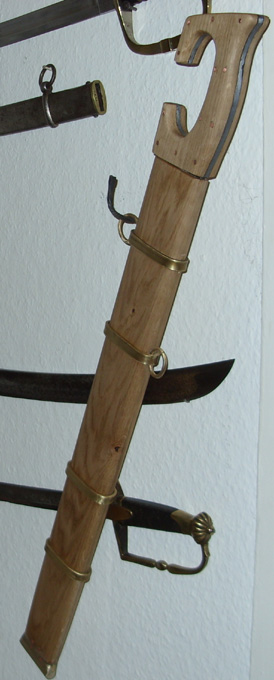
www.archaeoschmiede.de
www.eisenzeithaus.de
Last edited by Christian Böhling on Mon 01 Feb, 2010 11:26 am; edited 1 time in total
|
|
   |
 |
|
|
You cannot post new topics in this forum
You cannot reply to topics in this forum
You cannot edit your posts in this forum
You cannot delete your posts in this forum
You cannot vote in polls in this forum
You cannot attach files in this forum
You can download files in this forum
|
All contents © Copyright 2003-2024 myArmoury.com — All rights reserved
Discussion forums powered by phpBB © The phpBB Group
Switch to the Basic Low-bandwidth Version of the forum
|

